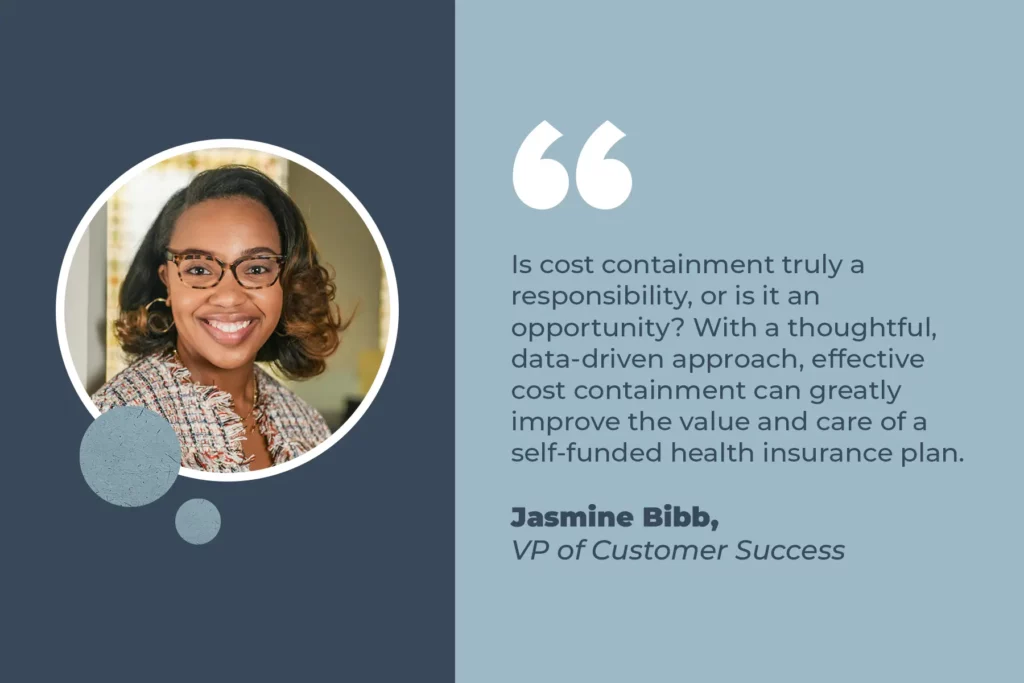- Customer success is an easy to measure metric: Are you delivering quality affordable employee health benefits over the long term? Are you happy with the experience engaging with your company health plan?
- Although it’s easy to measure, Roundstone is different in our approach to customer success because we already take into consideration customer alignment, minimizing risk, and providing data driven cost saving solutions.
- Roundstone further sets clients up for success because of our in-house Third Party Administrator’s (TPA) and its cohesive collaboration with our captive management team.
In a nutshell, customer success is quantifiable via a simple metric.
Customer success is measured in outcomes – With a self-funded health plan, an employer should expect to save considerable money over a five-year period without compromising on care or quality.
And you should have access to data to understand what’s happening in your health plan to implement cost saving solutions that not only optimize savings, but improve the care you provide your employees.
It’s both the employer’s budget and the employees’ experience that realize the success of a self funded group captive.
For example, a risk management company noticed they were spending $130 per member per month on pharmacy costs – higher than the commercial benchmark of $113 per month. The company implemented a vendor that provides PAP or International Sourcing options to groups and reduced that cost to $46 per member per month, resulting in over $60,000 in savings to the employee benefits plan in the past 10 months alone.
Many of the outcomes of a successful customer experience can be traced back to the quality of the Third Party Administrator (TPA) that facilitates the implementation and ongoing management of the company health plan.
As Vice-President of Customer Success at Roundstone, Jasmine Bibb understands customer success is an ever-evolving metric that never rests. It’s achieved through a formula that is repeatable even in the face of growth, but flexible enough to adapt to the inevitable growing pains of expansion. As Roundstone continues to maintain a steady, 30% year-over-year growth, customer success boils down to both the outcomes and experience along the way.
“If a customer is satisfied with the service, the experience, and the outcomes they receive from us, there’s real longevity and value in that success,” Jasmine said. “And I think that makes them happy because they’re not constantly going to market year after year – they have a reliable solution they can grow, improve and optimize through valuable long-term savings.”
Great Teamwork: The Value of an In-house TPA to a Company Health Plan
Because of their in-house, “all-under-one-roof” approach, both Roundstone and Bywater, our in-house TPA, are best positioned to deliver a successful customer through cohesive collaboration.
Having Roundstone and Bywater teams in the same building is a real differentiator because it leads to collaboration in real-time.
“It’s unique in this industry to have your captive manager and TPA work this closely together,” she added. “Both Roundstone’s and Bywater’s teams can have those critical conversations whenever there’s an issue. In most TPA relationships, those conversations are broken up in 24-to-48-hour periods. That closeness gives us a real advantage to work proactively for the customer.”
At Roundstone, we recommend groups work with Bywater because you can leverage several advantages – better integration to cost containment solutions, easier access to data, and a readily accessible team. And because Bywater is a part of Roundstone, we can better ensure total alignment to the customer’s needs. Most TPAs will charge a percentage of savings, vendor commissions, or other extraneous service fees. But Bywater doesn’t charge hidden fees – it only charges an all-encompassing admin and network fee. The network fee is assessed by Cigna but paid through Bywater.
But we don’t mandate Bywater as a TPA. You’re free to work with any TPA you choose, or we can recommend a TPA from a vetted list of preferred TPAs. The choice is up to you. It’s your employee benefits plan – and you have complete freedom to design it as you like.
Self-Funding in a Group Captive: The Great Risk Equalizer
Part of empowering a customer’s success is setting them up for a safe, comfortable, and predictable self-funding experience, no matter their size.
Roundstone’s group captive lets small to midsize companies leverage risk so you can safely self fund with the same confidence as the Fortune 500s, even if you only have 25 employees.
Without a stop-loss captive, most companies need at least 1,000 employees to have the risk predictability to safely self-fund their employee health benefits. With Roundstone, you pool your risk into a group stop-loss captive with many small to midsize companies so you achieve employee mass with safer predictability, even if your entire company can fit itself comfortably in a shuttle bus that seats 30.
Yet each company in the captive can have its own personalized plan, designed to meet the unique needs of its employee pool. Employers pay healthcare costs up to a specified deductible, say $16,000 to $25,000. Any claims beyond that deductible are then paid out of the stop loss captive. Claims above $500,000 are paid by reinsurance to avoid the expense of catastrophic claims. Under a group captive, your costs are capped.
By self-insuring employee health benefits under a group captive, employers can benefit from greater purchasing power and lower administrative costs while still maintaining control over their healthcare benefits. This can be particularly beneficial for smaller employers who may not otherwise have the resources to manage their own self-funded plans.
Teamwork Makes the Dream Work: The Value of Roundstone’s Team Model
The integration of Roundstone and Bywater delivers real stability, thanks to the customer service strategy based on a team approach. The collaborative means by which both companies tackle issues helps to ensure customer success.
We have a team of people focused on various aspects of the customer journey. Each team includes a Roundstone sales representative, or Regional Practice Leaders (RPLs) as we like to call them, who are supported by three to four Customer Outcome Managers who manage their entire book of business.
Each set or POD of Customer Outcome Managers is led by a Strategic Customer Outcome Manager, who works closely with the RPLs as a consultant to bring strategy to the customer, whether it be cost containment strategies, changes in plan design, or strategies to deliver the renewal – anything to push the customer forward toward success.
At the foundational level of each team sits the Service Outcome Manager, who focuses on the Bywater side and handles day-to-day transactions and concerns, like paid claims, prescription approval, and provider access – routine issues that occur every day in the life of every self funded health plan. The middle layer is the Resource Outcome Manager, who acts as a conduit between the two and is more administrative in nature. Each team works in synch to cover issues in a more streamlined fashion, so everyone is on the same page.
“Each team is focused on one specific customer to deliver success,” Jasmine said. “In most TPA arrangements, the book of business is split among many players. Our approach allows us to drive more cohesive collaboration on both sides to drive success for our customers.”
Ease of Use: Making the Switch to a Self-Funded Plan an Easy Lift
Another aspect of ensuring customer success is ensuring onboarding to a new self-funded plan is an easy lift and employers are assisted with hands-on instruction and training every step of the way.
“When a self-funded plan is easy to administer, it ensures a solution that creates a great experience,” Jasmine said. “That’s why we focus specifically on education and using key economics as a roadmap to help us navigate the journey to customer success. We’re there every step of the way with the employer and advisor so they aren’t on their own.”
A good example of this is our “What to Expect in the First Year” handout, which outlines the onboarding process to new captive members.
“We have tools and resources that aid in those early onboarding conversations that really set our clients up for success from the beginning,” Jasmine said. “Our goal is to make them wonder, ‘Why didn’t I do this sooner?’ We strive for ease of administration, right from the beginning.
“The misconception is that self-funding is a lot more work,” she continued. “We have strategically structured ourselves in a way that delivers the complete opposite experience. We support our customers every step of the way.”
Data-Driven Savings Through Integrated Cost Containment Solutions
In addition to the safety or risk predictability provided by a group captive, small to midsize companies can also access their plan data, so they have a clear understanding of costs and can therefore implement strategies to control those costs and further optimize savings. It’s the data that sets them up for real customer success – if they take advantage of it and harness its power to improve savings through cost containment solutions.
“When you’re self-funded as a result of the group captive, you do have access to the data and can understand what’s happening within your population,” Jasmine said. “If you choose to do so, you can take a step back and make your health plan more personal based on the actual needs of their population and the trends that you’re seeing. This can lead to considerable savings as well as enhanced care quality.”
It’s the data and deep integration to cost containment that is Bywater’s sweet spot, Jasmine explained. Many TPAs don’t integrate all the data or provide full access to all the cost containment tools. With Bywater, you can access the full spread, which gives you considerable leverage to get the most value from your self-funded health plan.
“Is cost containment truly a responsibility, or is it an opportunity?” Jasmine said. “With a thoughtful, data-driven approach, effective cost containment can greatly improve the value and care of a self-funded health insurance plan.”
Aligned for Better Healthcare: The Roundstone Difference
Roundstone’s collaboration for the sake of our customers is built around alignment. Being consistently aligned to the best interests of the employer shapes and focuses everything we do. We always ask: Is a cost containment tool, Pharmacy Benefits Manager (PBM), policy recommendation, etc. positioned to deliver real success to our clients?
“If we don’t have alignment, we have nothing,” Jasmine said. “There have been instances when we’ve had our growing pains and we’ve had to learn, but ultimately, it’s always done with the success of both the employer and advisor in mind. Alignment opens the door for us to be a resource that can lead to real longevity in employer and advisor relationships.”
Central to customer alignment is Roundstone’s transparency, she said. Roundstone doesn’t take commission or fee overrides, a practice Jasmine said is fairly unheard of in the insurance industry. Everything we do is in the best interest of the customer – not a second or third layer of a vendor fee.
“I think there’s a lot of mistrust when it comes to healthcare and health insurance,” Jasmine said. “But when employers come into business with us and meet our staff, our salespeople, and our customer service agents, they begin to realize there are some healthcare and health insurance solutions that truly strive to help those who need it the most. It’s a real difference.”
Alignment keeps our costs low, and we pass those savings on to the employer. If you take the same claims, put them in the Roundstone Captive, and put them in a competing captive, the Roundstone Captive will produce a greater return – every time.
It’s not just us saying that. The Validation Institute recently verified the Roundstone Captive delivers significant savings to customers.
That’s real customer success. It can be measured dollar for dollar in savings delivered to a company’s health plan, with no compromise on the care delivered. Affordable savings and quality care – that’s the Roundstone difference delivered in measurable ROI that resonates in real customer happiness and satisfaction. It can make all the difference to the self-funding experience.
How much can you save? Try our Roundstone cost calculator and see for yourself.










